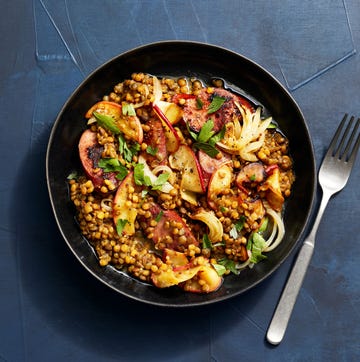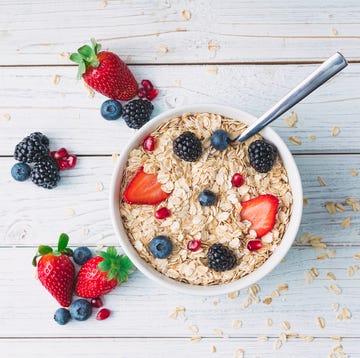10 High-Fiber Fruits to Add to Your Plate
They're filled with plenty of nutrients and they taste great.

Fiber is super important — and you're probably not eating enough of it. It turns out more than 90% of Americans don't include enough fiber in their diets! Fortunately, there are plenty of delicious fiber-filled foods you can add to your plate at any meal, including fruits.
What is fiber?
"Dietary fiber is a type of carbohydrate found in plant foods that the body can't digest," says Alma Simmons, R.D.N., L.D., C.D.C.E.S., a nutritionist at The Ohio State University Wexner Medical Center. "It comes in two forms: soluble which is dissolved in water and metabolized by the 'good bacteria' in the gut and insoluble which does not dissolve in water and functions mostly as a 'bulking' agent and may help speed the passage of food and waste through your gut."
The health benefits of fiber
Fiber is a nutritional superstar and the benefits abound. These are a few of the potential health benefits that fiber can provide, according to Simmons:
- Feeds beneficial gut bacteria and prevents constipation, which supports digestive health
- Lowers LDL cholesterol, which supports cardiometabolic health
- Slows sugar absorption, which supports diabetes management
How much fiber should you eat?
According to the Dietary Guidelines for Americans, most women should aim for 22 to 28 grams of fiber daily, depending on their age, while men should shoot for 28 to 34 daily grams of fiber. However, 90% of women and 97% of men don't hit those fiber targets. "Some people may need to limit the amount of fiber they eat, while others may need more total fiber or a specific type of fiber depending on their medical history and health goals," says Paige Heiden, M.S., R.D.N., a nutritionist at Culina Health. "Your registered dietitian can help you identify the right fiber goals for you."
The good news is that while most of us should eat more fiber, it's not difficult to find fiber-filled foods. Consider adding fiber-rich whole foods to your diet before you turn to supplements because they contain lots of other beneficial nutrients.
Just keep in mind that it's best to up your fiber intake slowly. "Increasing fiber rapidly can increase the risk of digestive discomfort like bloating, constipation/diarrhea and gas," says Gregory Lafortune, M.S., R.D.N., the founder of Optimal Plan Nutrition. "To help alleviate this, it is important to increase water intake when increasing fiber. Also, balancing insoluble fiber sources (whole grains, nuts/seeds, skins of fruit) with soluble fiber sources (citrus fruits, oats, apples, flax seeds) can help."
High-fiber fruits
To start, consider adding the high-fiber fruits listed below to your summer menu.
Rachel Lustgarten (she/her), M.S., R.D., C.D.N., is a registered dietitian in clinical practice in New York City. Her primary area of focus is medical nutrition therapy and weight control. Rachel’s passion is sharing her knowledge and expertise of food and nutrition’s role in overall health and wellness. She co-hosts the weekly “Primary Care Medicine” show on SiriusXM Doctor Radio, interviewing expert guests and fielding listener calls and questions about hot topics in health and nutrition. She served as a clinical dietitian at the Comprehensive Weight Control Center at Weill Cornell Medicine and served as an Advisor to the Weill Cornell’s Women’s Nutrition Connection monthly newsletter for 10 years. Rachel received a Master’s degree in Clinical Nutrition from New York University, graduating with honors.

Readers Also Read

Go All in on These High-Protein, High-Fiber Meals

Can You Boost GLP-1 Naturally with Food?

10 Foods Full of Protein and Fiber

A List of the Healthiest Fruits You Can Eat

















